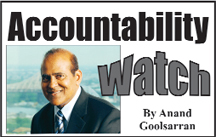The Integrated Financial Management System (IFMAS), which the Guyana Government implemented in 2004, has been under the microscope in recent days in the Kaieteur News. The issue at hand is that the Ministry of Finance is yet to activate two of the most important modules of the seven-module automated system: the Purchasing and Asset & Inventory modules.
What is IFMAS?
IFMAS (or IFMIS) is an IT-based budgeting, accounting and reporting system that manages spending, payment processing, budgeting and reporting for governments and other entities. It incorporates essential financial management functions into one software suite that can be an off-the-shelf one or a custom-made system, depending on the size and needs of the organization using the system. If fully and properly implemented, including ensuring requisite training for key operatives of the system, IFMAS can improve significantly an organization’s financial management practices through better management of cash resources; improved accountability for all assets (including inventories) and liabilities; more timely and accurate budget and financial reporting; enhanced decision-making; and improved overall efficiency and effectiveness of operations. These could in turn lead to significant cost savings.
 According to the Anti-Corruption Resource Centre, emerging information and communication technology (ICT) can play an important role in fighting corruption in public finance systems by promoting greater comprehensiveness and transparency of information across government institutions. As a result, the introduction of Integrated Financial Management Systems has been promoted as a core component of public financial reforms in many developing countries. The Centre, however, offered the following words of caution:
According to the Anti-Corruption Resource Centre, emerging information and communication technology (ICT) can play an important role in fighting corruption in public finance systems by promoting greater comprehensiveness and transparency of information across government institutions. As a result, the introduction of Integrated Financial Management Systems has been promoted as a core component of public financial reforms in many developing countries. The Centre, however, offered the following words of caution:
Yet, experience shows that IFMIS projects tend to stall in developing countries, as they face major institutional, political, technical and operational challenges. Case studies of more successful countries indicate that factors supporting successful implementation include clear commitment of the relevant authorities to financial reform objectives, ICT readiness, sound project design, a phased approach to implementation, project management capability as well as adequate resources, and human resource capacity allocated to the project.
Sierra Leone, one of the countries that began the implementation of IFMAS around the same time as Guyana, suffered immensely from the ravages of civil war during the period 1991 to 2002, resulting in a complete destruction of all systems of public accountability. The implementation process was sequenced in three phases while the Purchasing and Asset & Inventory modules were rolled out in January 2006. By the end of 2006, IFMAS was implemented at the Ministries of Health, Education, Agriculture, Works and Auditor General’s Department.
Other countries that have enjoyed a relatively smooth and successful implementation of IFMAS include the Slovakia, Kosovo, Tanzania and Ethiopia.
Implementation of IFMAS in Guyana
Prior to 2004, the Government’s financial management systems operated largely on a manual basis. The introduction of IFMAS was therefore not only timely but also a step in the right direction to take advantage of advances in information technology and to lessen the burden and paperwork associated with manual systems. A Canadian-based software company was contracted to undertake the exercise with the objective of “rapidly implementing a robust integrated budgeting and accounting system for the Government and to further the modernization of the public financial management system of the country”.
IFMAS was implemented on a distributed network platform that included a Wide Area Network (WAN) and many Local Area Networks (LANs). Over 100 computers and supporting equipment were installed in all the accounting units of the Ministries, Departments and Regions. There are seven modules, namely, Appropriation, Expenditure, General Ledger, Budgeting Preparation System and Reporting System (BPRS), Purchasing, Revenue and Asset & Inventory modules. An integral component of the programme involved training of staff to provide them with the skills needed to operate the system. This task was completed by October 2003 in preparation for the roll-out in January 2004 of the first three modules.
At a seminar on 1 March 2006, the then Canadian High Commissioner stated that the improvement of the management of public finances is a movement towards more efficient and transparent public administration and consequently, better governance. The then Minister of Finance added his piece:
Progress of IFMAS so far, represents a quantum leap from the period when government accountants and financial managers were inundated with tons of paper and multiples of filing cabinets…Government is committed to the development and sustainability of IFMAS in the future…To consolidate IFMAS this year, government will be configuring and installing new modules that include state-of-the-art budget preparation and reporting system, and revenues, purchasing and asset management programmes…The great emphasis placed by the government on public accountability and sound and effective management of public finances is widely known.
Following the 2006 national elections, the then Minister of Finance was replaced by the current Minister. Since then, two additional modules – Budgeting Preparation and Reporting System (BPRS); and the Revenue Module – were implemented, leaving the remaining two modules – Purchasing; and Asset & Inventory – unimplemented to date.
The Purchasing and Assets & Inventory Modules
These two modules are very much interlinked in that they both involve public procurement which the single most important financial management activity of the Government, accounting for approximately 70 per cent of the national budget, or $150 billion. They have the ability to automatically generate purchase requisitions and purchase orders when stock levels reach the re-order points, and to reserve the necessary funds to do so. In addition, they record the receipt of goods and update the related inventory and asset records.
The two modules are basically a computerization of any manual procurement system involving the creation of purchase requisitions, placing of purchase orders, tracking the receipt of goods and their recording, and monitoring of stock levels. However, given the extent of Government operations, it is inconceivable, especially at this day and age, that we have not seen the necessity of automating our procurement and asset/inventory systems. According to the 2012 Estimates, there were 80 agencies and 116 programmes under current expenditure while under capital expenditure there were 107 programmes. All these agencies and programmes are invaolved in procurement and asset/inventory accounting.
A typical private sector organization will not survive without an automated system in place for procurement and asset/inventory accounting. It is also no wonder that the Auditor General’s reports over the years are riddled with irregularities and discrepancies, indeed a lack of proper accountability, relating to the procurement of goods and services and the execution of works. How could one conceivably manage such a system using a manual approach?
The Procurement Act 2003 details the procedures to be followed in the procurement of goods and services and the execution of works. Prior to then, the Constitution was amended in 2001 to provide for the establishment of the Public Procurement Commission to oversee the entire procurement process. However, to date this Commission is yet to be established. It is public knowledge also that the present system is controlled entirely by the Government, with the Minister of Finance appointing the members of the National Procurement and Tender Administration Board with reporting relationship to him; and Cabinet having the final say in the award of contracts in excess of $15 million. To compound matters, after ten years, two of the most important modules under IFMAS have not been implemented, despite assurance given year after year that this would be done.
Auditor General’s reports on IFMAS
In March 2006, the Auditor General reported that three modules were operational – General Ledger, Appropriation and Expenditure. However, several agencies did not maintain essential records, and the input of data into the system was also not consistent. He also reported the Accountant General as having stated that: (a) the budget module and bank reconciliation tool were being implemented; (b) plans were in place to implement the Purchasing, Revenue, and Asset & Inventory modules along with reporting software; and (c) training would be conducted to upgrade skills of employees.
In July 2007, the Auditor General stated that a fourth module – Revenue – had been implemented while at the same time repeating his comments of the previous year. He spoke about the benefits achieved so far by IFMAS, and reported, without comment, the Accountant General’s explanations made in the previous year as regards the Budget, Purchasing and the Asset & Inventory Modules as well as training to upgrade skills of employees. In his later reports, however, the Auditor General’s interest appeared to have waned. He was considerably less vocal, and his brief comments were a repetition of those of the previous years. In fact, in his 2006, 2007, 2008 and 2009 reports, there was no reporting on IFMAS, except for brief statements in the Executive Summary.
In his 2010 report, the Auditor General appeared to have regained some interest in IFMAS but his comments were casual and innocuous. He chose not to take the Accountant General to task for his failure to honour the promises made in the previous years to rectify the deficiencies identified and to have the two remaining modules activated. Regrettably also, is the fact that the Auditor General’s comments for the years 2011 and 2012 were a mere “cut and paste” of what was written in his 2010 report. Nor did the Auditor General seek to identify the causes for the failure to implement the two modules and to assess the implications in terms of the proper accountability for all assets/inventories acquired over the years.
To be continued –








